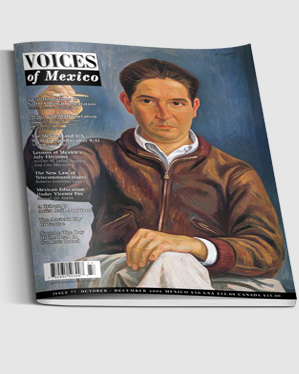Voices of Mexico no. 77
Our Voice
In these times, when the superpower is indifferent, it is not a bad thing that someone from the northern part of the hemisphere pays attention to the southern part of the Americas. This should perhaps, however, be done with all due caution and reservation because the United States’ emphasis on its hemispheric agenda’s security issues since 2001 —a return to the warrior mentality— has gravely distracted from topics fundamental to the area. Mexico has also fallen into the trap of this “distraction,” not without the influence of vested interests. Economic progress and democracy have been sacrificed, and today they must be dealt with in a new way if we want to make sure that the twenty-first century does not bring our nations new cycles of crises.
Recently there has been a heated debate about the routes to be followed to deal with issues pending in the hemisphere. The road has not been easy and the climate of the debate has had its ups and downs, caused largely by the United States’ confusing policies in the region. For better or worse, we find ourselves in a region that has been part of the U.S. sphere of influence. From that perspective, our region —mainly Mexico and Central America— has been treated like the “American Mediterranean.” This analogy, conceived by Alfred Mahan, the first U.S. geo-politician, established a strong parallel between the strategic importance of the Mediterranean Sea for the great nineteenth-century European powers and that of the Caribbean Sea and Central America for the United States in the early twentieth century. Certainly, a country’s geographical position favors the concentration of its power and gives it a greater possible strategic advantage vis-à-vis its rivals. This is the basis for Washington’s persistent quest for hegemony, its reiterated blindness and its permanent tendency to intervene in other countries’ affairs even if it is not justified, which has caused a lasting paralysis in the formulation of U.S. policy toward its southern neighbors, let alone those placed in other distant regions of the world.
Editorial
![]() Our Voice
Our Voice
José Luis Valdés-Ugalde
Politics
![]() Fraud or Human Error in Mexico’s Presidential Election?
Fraud or Human Error in Mexico’s Presidential Election?
Javier Aparicio
![]() Conditions for Competition
Conditions for Competition
The Necessary Electoral Reforms
Ciro Murayama
Society
![]() The Media in Mexico Power with No Checks or Balances
The Media in Mexico Power with No Checks or Balances
Roberto Gutiérrez L.
![]() Mexican Education From Great Hopes to Human Chiaroscuros
Mexican Education From Great Hopes to Human Chiaroscuros
Manuel Gil Antón
![]() Cultural Revisions of Gender And the Mexican Revolution
Cultural Revisions of Gender And the Mexican Revolution
Kristine A. Byron
Mexican Foreign Affairs
![]() Mexico and the UN Security Council
Mexico and the UN Security Council
Roberta Lajous
![]() Mexico and Multilateral Diplomacy
Mexico and Multilateral Diplomacy
Jorge Eduardo Navarrete
![]() Toward an Activist Foreign Policy: Mexico, Multilateralism and the Americas
Toward an Activist Foreign Policy: Mexico, Multilateralism and the Americas
Luis Jiménez McInnis
North American Issues
![]() North American Security
North American Security
And Development Agendas
Five Years after 9/11
María Cristina Rosas
![]() The Social Dimension of North American Integration:
A View from Mexico
The Social Dimension of North American Integration:
A View from Mexico
Carlos Heredia Zubieta
![]() Immigration to Migration
Immigration to Migration
John Burstein
In Memoriam
![]() Jaime Litvak King, “A Helluva Guy”
Jaime Litvak King, “A Helluva Guy”
Joel Santos
Museums
![]() The Federico Silva Contemporary
Sculpture Museum
The Federico Silva Contemporary
Sculpture Museum
Sylvia Navarrete
Ecology
![]() The Despoblado
The Despoblado
Raymond Skiles
Literature
![]() Short Poetry of San Luis Potosí
Short Poetry of San Luis Potosí
Norberto de la Torre
Reviews
![]() Seguridad nacional en México. ¿Realidad o proyecto?
Seguridad nacional en México. ¿Realidad o proyecto?
Silvia Núñez García
![]() America at the Crossroads: Democracy, Power, and the Neoconservative Legacy
America at the Crossroads: Democracy, Power, and the Neoconservative Legacy
Adrián Villanueva Delgado
The Splendor of Mexico
![]() Tamtoc
Tamtoc
Guillermo Ahuja
![]() The City of San Luis Potosí
The City of San Luis Potosí
María Isabel Monroy Castillo
![]() Huiricuta
Huiricuta
The Routes of the Huichols
Leonardo Fernández Borja
Art and Culture
![]() A Tribute to Raúl Anguiano (1915-2006)
A Tribute to Raúl Anguiano (1915-2006)
![]() Xantolo in the Potosí Huastec Region
Xantolo in the Potosí Huastec Region
Fernando Domínguez García
![]() The Lila López International
The Lila López International
Contemporary Dance Festival
Juan Carlos González Islas

